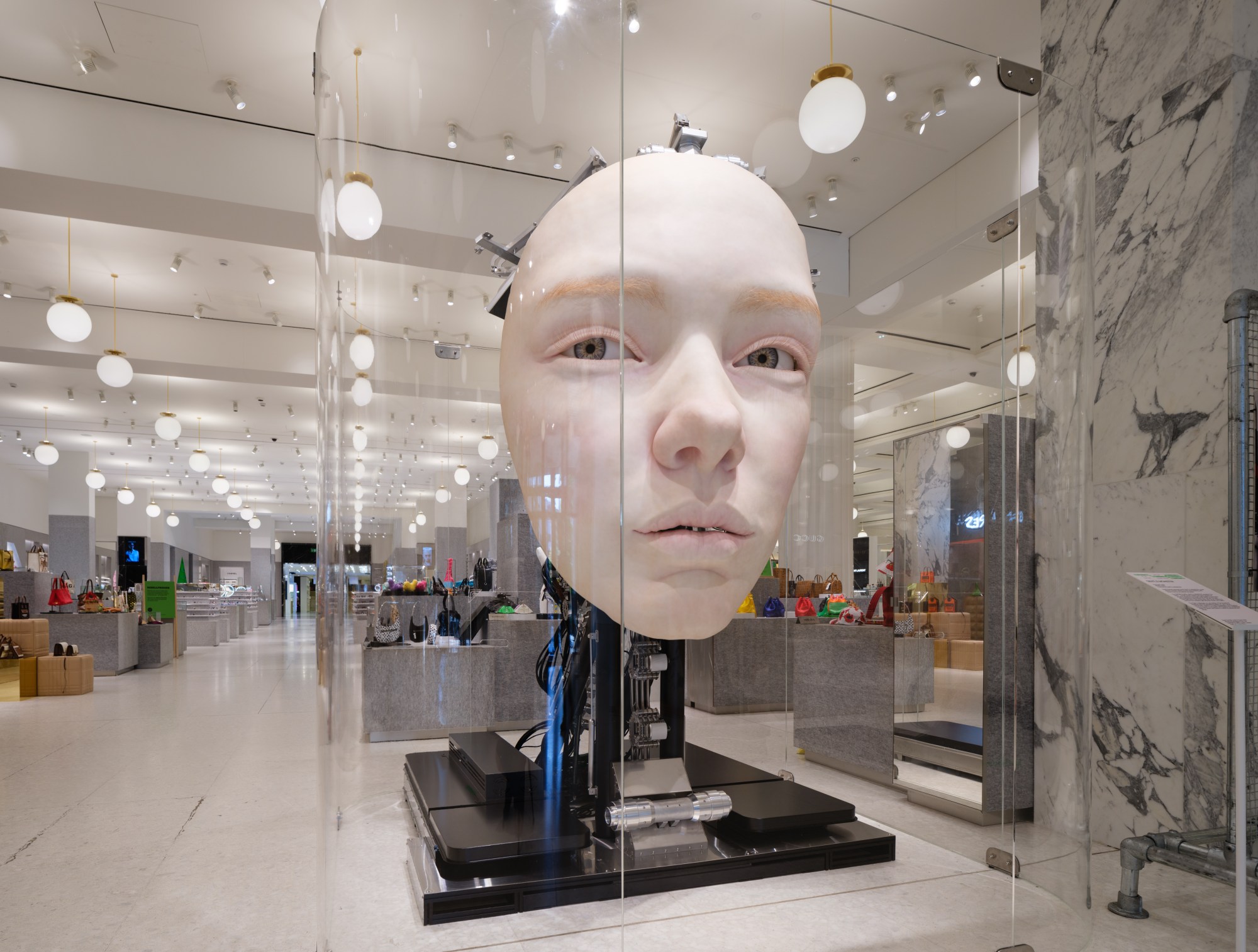In times as precarious as these, you’re not alone if being asked, “what could the future look like?” fills you with dread. It is, after all, a pretty bold question, but with tomorrow and the days after feeling less certain than ever, giving an answer with any real conviction is pretty tough. According to a new exhibition at Selfridges, though, the fact that the horizons ahead are so damn clouded is exactly what makes devising ambitious responses so crucial.
Comprising 13 distinct installations and interventions by artists and brands including Sevdaliza, Monira Al Qadiri, Ottolinger, Gentle Monster and Nico Vascellari; SUPERFUTURES explores and imagines what our future world might look like, and what our roles within it will be. The brainchild of the team behind Berlin-based communications agency Reference Studios (who also pioneered the genre-irreverent Reference Festival) and curated by Agnes Gryczkowska, the expansive exhibition broaches the great existential questions of our time. Exploring everything from the cruxes of contemporary identity politics to the realities of living at the advent of global climate catastrophe, SUPERFUTURES culminates in asking: What sort of planet do we all want to live on?
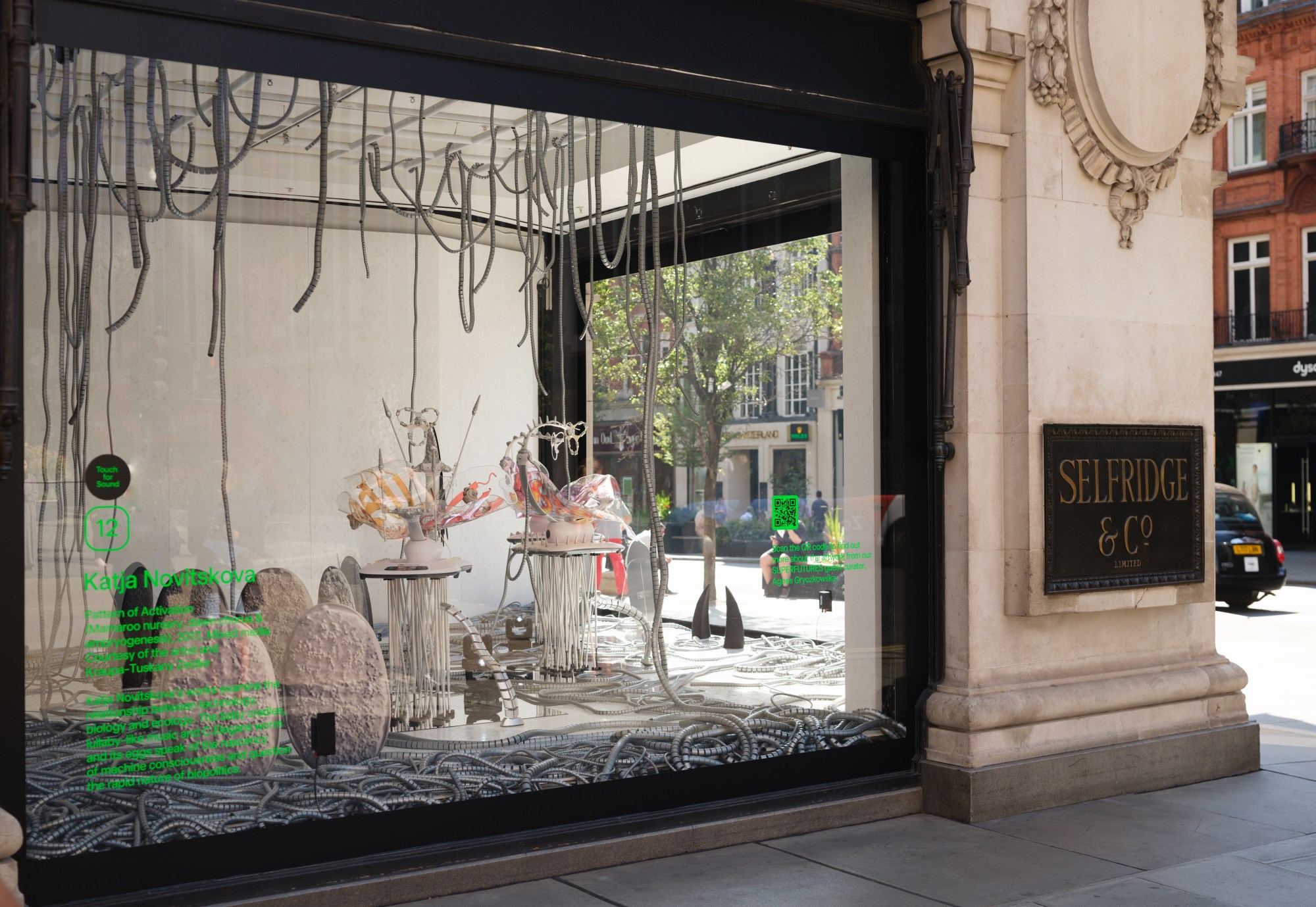
Rather than arrogantly map out pathways to reach utopia, though, the exhibition and the works it comprises pose open-ended questions that prompt similarly free-minded reflection. “There are so many things in the world right now that urgently require our attention. We don’t intend to point fingers with this exhibition, and of course, we don’t have all the answers,” Mumi Haiati, Reference Studios’ founder and CEO, notes. “Rather, SUPERFUTURES is an exercise of questions, and provides a great variety of prototypes for the future – which is now! A particularly noteworthy comment that is part of the show is a quote and artwork by Nico Vascellari: “In Dark Times We Must Dream with Open Eyes”. It’s so applicable at this moment in time.”
As ambitious and profound as the exhibition’s thematic scope is, what amplifies its resonance is its physical context. Luxury department stores of global renown aren’t typically where you go to engage with art themed around insect and snake genitalia or fossil fuel consumption. But that only gave the team organising the exhibition all the more reason to put it there, especially given the daily footfall Selfridges’ garners – which, it probably doesn’t need stressing, is significantly higher than most galleries.
“SUPERFUTURES is intended to be thought-provoking – a literal and metaphorical intervention to the shopping experience, and one which we hope can be engaged with in different ways by a broad and diverse cross-section of people,” Emma Kidd, Selfridges’ Creative Director, says. “And I strongly sympathise with the idea of art for the people. With SUPERFUTURES, we have a platform to inspire urgent thoughts in people who perhaps wouldn’t usually attend an art exhibition,” Mumi concurs. “The retail environment becomes a place to start a dialogue with visitors, and there are millions of them.”
Below, Agnes, the exhibition’s curator, and six of the exhibition’s participating artists expand on the significance of their work, how they hope the millions of shoppers that will see the show will respond to it, and the super futures they have in mind.

Agnes Gryczkowska
What was the conceptual jumping-off point for SUPERFUTURES? What conversations was it a product of?
The exhibition is the third chapter of Selfridges’ one-year-long exploration of the future, similar to the Protopia edition of Reference Festival in Berlin last year, exploring a range of futurist scenarios. Speaking of the future in 2022 is not the easiest task. The physical world – as we know it – is transforming, mutating and breaking down incredibly fast. The jumping-off point was an attempt to react to this moment in history and to explore the issue of transformation and mutation. We are at a point of an interesting junction – on the one hand, the world is seemingly becoming more open to fluidity, more accepting of non-conformity, more acknowledging of those who have forever been deprived of their rights, more protective of the planet; on the other hand, society is becoming more controlled, more ‘tracked’, more trend-driven, more homogeneous, and the ecosystems of planet are disappearing, as they are being brutally manipulated by the human dwellers. As if the planet and its species were becoming a commodity.
What made Selfridges, a space people typically associate with retail, the ideal space for this show? And how did the presentational context inform your curatorial approach?
It is not ideal, but it is an interesting one. Most of the works selected for the show are ‘shiny’ products, yet upon some unpacking, they are dark, critical and stimulating. Take Monira Al Qadiri’s Amorphous Solid Ghost – the beautiful, precious Murano glass sculptures, resting on the balconies of the Selfridges’ main atrium are in fact shaped as oil drill heads… Another reason why this context is an interesting one is the fact that nothing is isolated. Everything affects and effects something – our choices and movements as consumers have a huge impact on our ecosystems and our lives. Putting these works inside of a busy retail environment additionally highlights this.
What drew your eye to the artists that have been included in the show The artists featured in the show critique prevailing human behaviours, reframing our understanding of the future and presenting a world that is an endless loop of interconnections. Everything leads to something. They reframe the pre-existing distinctions between humans, nature, objects, non-beings, technologies, and between different realities: physical, spiritual and virtual. Selected works encourage mutation and cohabitation. What is interesting about the selected artists is the fact that none of them operate within one realm – they work at intersections of art and biology, technology, economics, physics, robotics, philosophy, music, magic and myth-making.
What do you hope audiences will take away from the show?
The aim is that the, at points hopeless, at points hopeful visions of the future presented in the exhibition serve as endless reminders that the planet and humans are full of transformative potential. In a worldview where the features of one element constructively enhance the attributes of the others, it is possible to see diversity not as separation but as complementarity. As socio-political shifts attempt to increase hierarchies and homogeneity, the show suggests a future that is a hybrid – a rhizomatic queerness and a desiring machine.
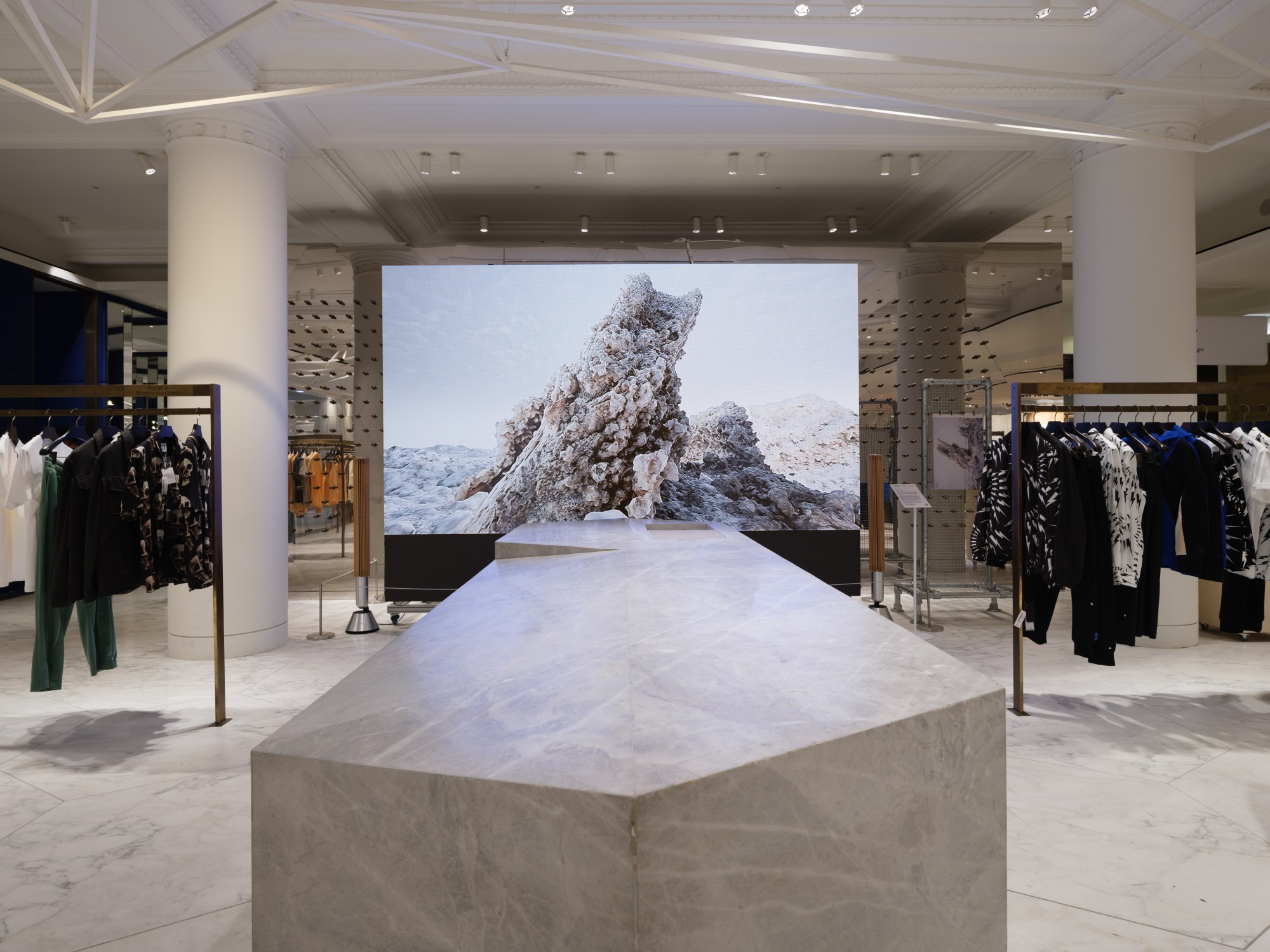
Jakob Kudsk Steensen
How would you introduce the work you’re exhibiting?
Liminal Lands takes place between familiar and unfamiliar zones of existing, and across multiple time scales. It is virtual, but made of sounds and 3D scanned elements I encountered across the Camargue wetlands during lockdown in France like algae, bacteria, crystallised wood and salicornia plants. Across the many elements, it suggests a completely fluid future where different scales of life, from bacteria to entire landscapes, communicate with each other and us, through technologies.
SUPERFUTURES “suggests a future that is hybrid — a rhizomatic queerness and a desiring machine,” says Agnes, the show’s curator. How would you position your work with respect to this statement?
We are exiting the modernist paradigm of categories of species, gender, identity and borders, towards a fully fluid realm. All my work deals with this as a core belief system which I advocate for. The future can be poetic and rhythmic, letting us dance to the beats of volcanic ridges, rainfalls and bacteria moving across bodies and ecosystems.
How do you hope audiences will engage with/respond to your work, and to the show more generally?
I hope they get both a sense of displacement and pleasure. The video lures them into a realm of fascination for rarely documented and thought-about natural formations in wetlands, and introduces them to new ways of perceiving how life across different scales of existence interconnect.
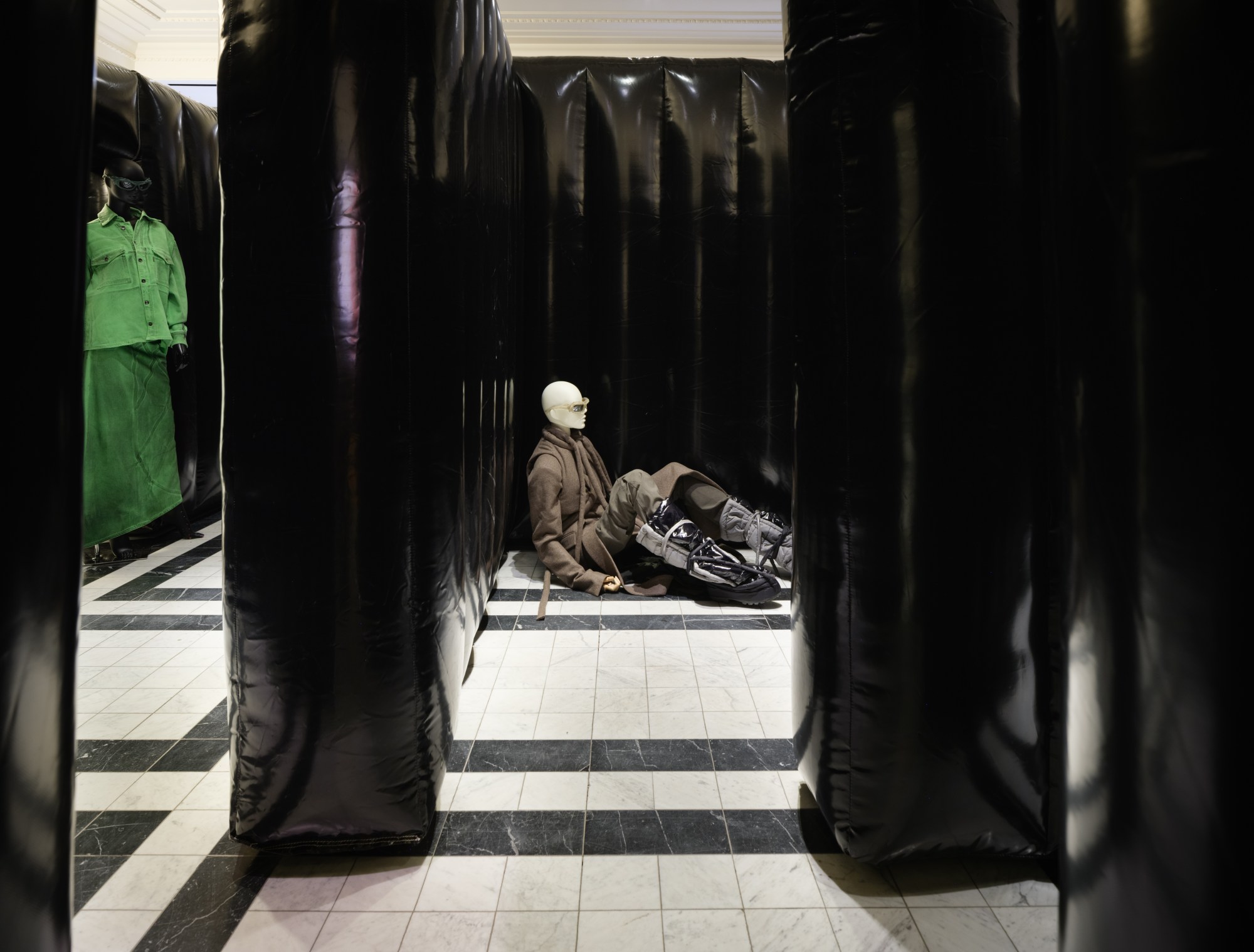
Ottolinger
How would you introduce the work you’re exhibiting?
The work is based on Jan Vorisek’s artwork Devotion Strategy which he exhibited at the Kunsthaus in Glarus, Switzerland. We love Jan’s work and teamed up for our last collection’s video – it felt (and still feels, even more than ever) as if everything is collapsing, that we can’t be certain of what will happen and that we all are ready for a new hyper-reality and a complete transformation of space.
SUPERFUTURES “suggests a future that is hybrid — a rhizomatic queerness and a desiring machine,” says Agnes, the show’s curator. How would you position your work with respect to this statement?
It feels very uncertain to talk about the future at the moment. What keeps us driving is hope. Hope to achieve a future that is hybrid, desirable, accepting, tolerant and peaceful!
How do you hope audiences will engage with/respond to your work, and to the show more generally?
We would love the audience to walk inside the labyrinth – to explore the feeling of being lost, to feel a sense of collapsing and a loss of orientation, while experiencing a feeling of warmth and protection, and of being unafraid, all at the same time. It loads us with energy, and cloaks us in confidence and hope that we can navigate through the collapse and towards the future.
Jan Vorisek
How would you introduce the work you’re exhibiting?
Devotion Strategy (2020-2022) is a pneumatic, dungeon labyrinth-like padded cell which is made of pitch-black PVC. Its eerie atmosphere, inspired by body horror and sci-fi, addresses a psychological spectrum between desire, anxiety, euphoria, and repulsion. Through material and illusion, it highlights how spaces shape our feelings. Through the motif of the labyrinth, the feeling of latent, spatial panic is infinite. The installation also features a drone track playing through a comcast system, that is in tune with the blower of the inflatable. Together they elevate the room further into the territory of the subliminal mind.
SUPERFUTURES “suggests a future that is hybrid — a rhizomatic queerness and a desiring machine,” says Agnes, the show’s curator. How would you position your work with respect to this statement?
My installations and sculptures stand in relationship to a psychosocial logic and play with physical and spatial impulses between sexualisation and fear, angst and delirium. The negative space and these feelings, and whether their collapse is still imminent or has already occurred, is unclear.
How do you hope audiences will engage with/respond to your work, and to the show more generally?
Ask a provocative question. State a fact that is troubling, amusing, or remarkable. Define unfamiliar terms.

Joey Holder
How would you introduce the work you’re exhibiting? What are its main thematic preoccupations?
Its title is aequator, which means ‘equator’ in Latin, as well as ‘to make equal’. The installation is formed of two symmetrical grids, which house vivariums on either side, with a central landscape representing a celestial object, water and the equator. The gold celestial bodies are 3D printed models based on the formations of snake genitalia. The models express the myriad of exquisite forms and mating practices found in the animal kingdom which are often invisible to the naked eye. We often imagine what life is like on other planets, other worlds, yet what is present right under our noses is stranger than we can imagine – far more ‘alien’. Most of the world’s natural life remains undiscovered – despite all our technologies, we still don’t know most of the bacterial life that exists in the palms of our own hands.
SUPERFUTURES “suggests a future that is hybrid — a rhizomatic queerness and a desiring machine,” says Agnes, the show’s curator. How would you position your work with respect to this statement?
The installation presents itself like a national history museum exhibit, displaying amalgamations of specimens in cabinets of curiosities. My motivation for enlarging the genitalia of a variety of species of insects and snakes is to challenge our anthropocentric constructs around sexuality. Off the back of Darwin’s concept, Western society formed a destructive set of moral codes that placed heterosexual reproductive sex as ethically pure and progressive, while all other reasons for having sex became not only amoral, but also prohibited or restricted by social custom. These assumptions in the field of evolutionary biology have also led to a toxic understanding of gender roles and claims that males are naturally thought to be promiscuous, dominant and aggressive, and females chaste and passive. These biologically affirmed traits of what is ‘natural’ and what is ‘normal’ have leaked into oppressive structures of human governance, gender inequality and sexual exploitation over the decades, and still do.
How do you hope audiences will engage with/respond to your work, and to the show more generally?
I hope that viewers will find something unexpected here. With the displays integrated throughout the consumer goods and brand displays, it will make unsuspecting shoppers stop and look twice at the otherworldly exhibit. My motivation for making these installations is to undermine what is, culturally and societally, understood as ‘normal’ and ‘desirable’ – letting the mind trip through a kaleidoscope of possibilities and allowing the viewer to begin to commune with something that is not human; a hybrid of us and others.

Monira Al Qadiri
How would you introduce the work you’re exhibiting? What are its main thematic preoccupations?
I’m showing several works that revolve around the topic of our addiction to fossil fuels, like oil and gas, and their derivatives. In my new project BENZENE FLOAT, the chemical drawings used to illustrate benzene, propane gas and others are blown up into huge inflatable sculptures, occupying the central atrium next to moving escalators like an elephant in the room. The idea is that our dependence on these substances can no longer be ignored, and it is completely unsustainable in the long term. On the third floor, you will see my sculpture “Deep Float” in which it appears a person is drowning in a bathtub of oil.
SUPERFUTURES “suggests a future that is hybrid — a rhizomatic queerness and a desiring machine,” says Agnes, the show’s curator. How would you position your work with respect to this statement?
I agree with this statement, in that my works are hybrid in their meaning. On the surface, they appear to be colourful, shiny and fun – essentially visually appealing — but underneath they are very dark and riddled with doubts about our place in the world. Completely antagonistic views are embedded into one object: this is what piques my interest in making art.
How do you hope audiences will respond to your work, and to the show more generally?
I believe that the setting inside the store can somehow be considered even more public than public space. Thousands of people will pass by and see the works every single day, even if they are not meaning to specifically look at art. They will be confronted by these things, confused by them, and hopefully intrigued to pursue their ideas and meanings. That’s what excites me about this unusual collaboration.
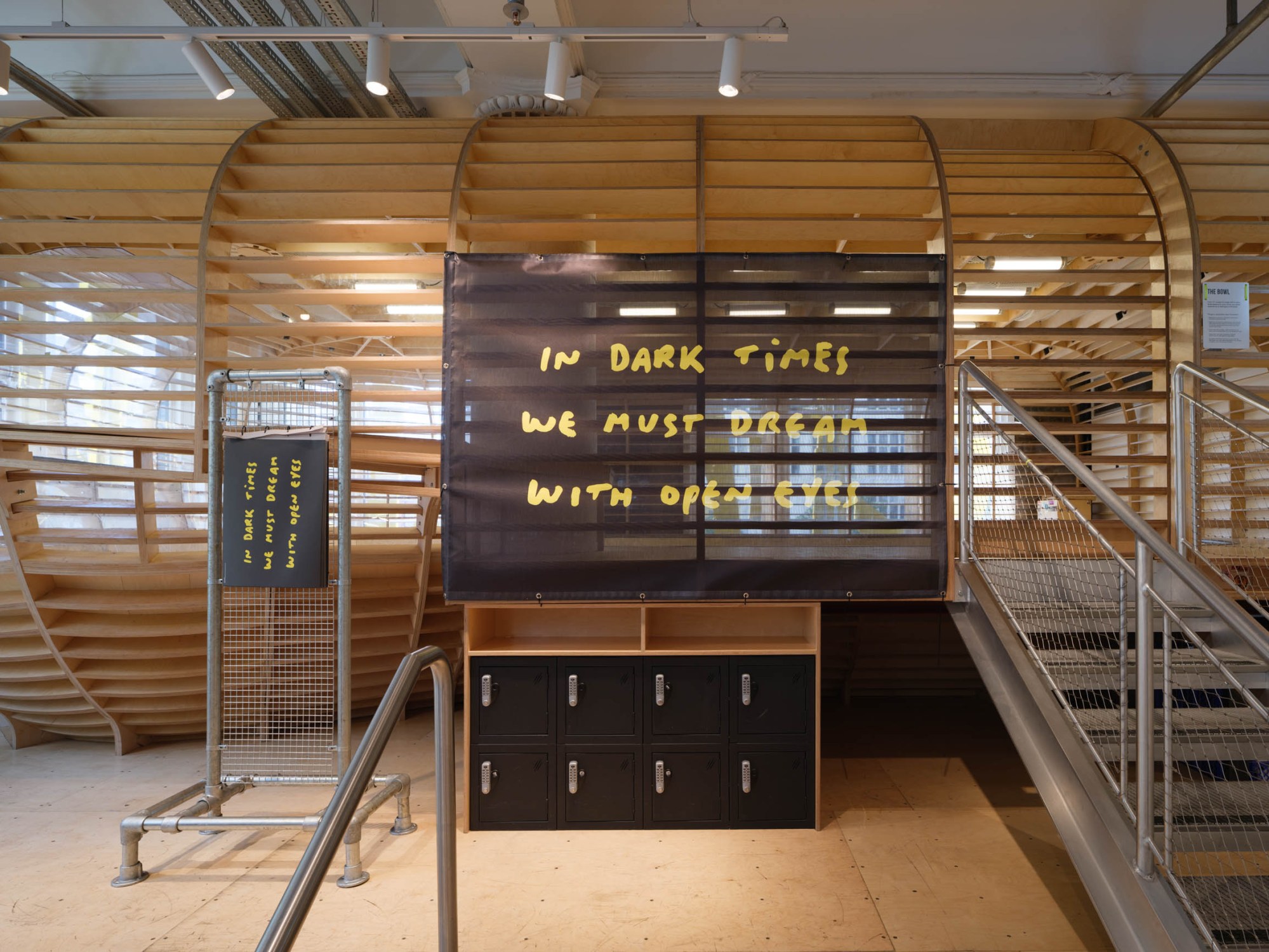
Nico Vascellari
How would you introduce the work you’re exhibiting?
“In Dark Times We Must Dream With Open Eyes” is a manifesto I have written in 2019. It is a hymn to struggle and resistance which I have diffused since then as a flag or t-shirt through the website of Codalunga, my studio.
SUPERFUTURES “suggests a future that is hybrid — a rhizomatic queerness and desiring machine,” says Agnes, the show’s curator. How would you position your work with respect to this statement?
Looking at this statement of mine, written on a flag or a T-shirt, I almost needed to see it out there in order to fully believe it. We have been told since day one to look at the world from a linear perspective… You have right on one side, wrong on the other. To me, everything has a double nature. It is not a line but a circle.
How do you hope audiences will engage with/respond to your work, and to the show more generally?
The hope is always to raise questions and create doubts. After all, it is only through embracing a process of total uncertainty that our investigations become more profound.
Follow i-D on Instagram and TikTok for more on art.
Credits
Images courtesy of Selfridges & Reference Studios
